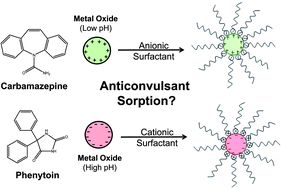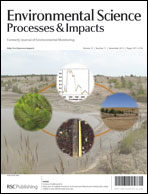Influence of organic surface coatings on the sorption of anticonvulsants on mineral surfaces†
Abstract
Here, we explore the role that sorption to mineral surfaces plays in the fate of two commonly encountered effluent-derived pharmaceuticals, the anticonvulsants phenytoin and carbamazepine. Adsorption isotherms and pH-edge experiments are consistent with electrostatics governing anticonvulsant uptake on metal oxides typically found in soil and aquifer material (e.g., Si, Al, Fe, Mn, and Ti). Appreciable, albeit limited, adsorption was observed only for phenytoin, which is anionic above pH 8.3, on the iron oxides hematite and ferrihydrite. Adsorption increased substantially in the presence of cationic and anionic surfactants, species also commonly encountered in wastewater effluent. For carbamazepine, we propose the enhanced uptake results entirely from hydrophobic interactions with apolar tails of surfactant surface coatings. For phenytoin, adsorption also arises from the ability of surfactants to alter the net charge of the mineral surface and thereby further enhance favorable electrostatic interactions with its anionic form. Collectively, our results demonstrate that although pristine mineral surfaces are likely not major sinks for phenytoin and carbamazepine in the environment, their alteration with organic matter, particularly surfactants, can considerably increase their ability to retain these emerging pollutants in subsurface systems.


 Please wait while we load your content...
Please wait while we load your content...